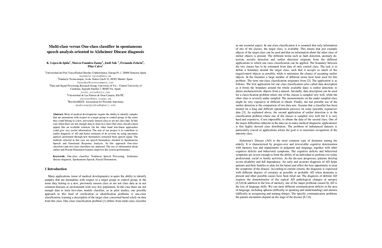Multi-class versus One-class classifier in spontaneous speech analysis oriented to Alzheimer Disease diagnosis
Most of medical developments require the ability to identify samples that are anomalous with respect to a target group or control group, in the sense they could belong to a new, previously unseen class or are not class data. In this case when there are not enough data to train two-class One-class classification appear like an available solution. On the other hand non-linear approaches could give very useful information. The aim of our project is to contribute to earlier diagnosis of AD and better estimates of its severity by using automatic analysis performed through new biomarkers extracted from speech signal. The methods selected in this case are speech biomarkers oriented to Spontaneous Speech and Emotional Response Analysis. In this approach One-class classifiers and two-class classifiers are analyzed. The use of information about outlier and Fractal Dimension features improves the system performance.
PDF Abstract
